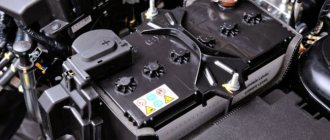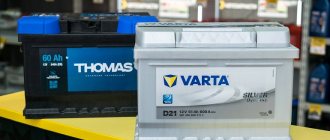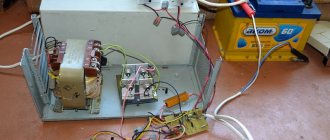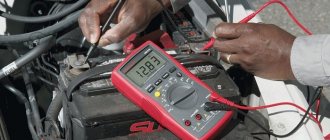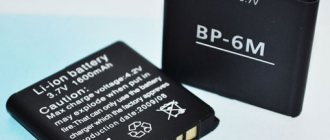A car battery has a number of parameters according to which it can be selected for a particular vehicle. And this is not only dimensions, weight, location of pins. These are also electrical characteristics by which one can judge the purpose of the battery. Today in stores you can find batteries for motorcycles, cars, trucks and special equipment. They are all different in their performance. Even for different classes of passenger cars, batteries differ in their electrical parameters. If you choose the wrong battery, problems may arise during subsequent operation. One of the key characteristics of a battery is capacity. We'll talk about it today.
Main battery characteristics
The main characteristics of a car battery include the following:
- Electromotive force;
- Cold crank current;
- Capacity;
- Weight;
- Standard size;
- Polarity;
- Degree of charge;
- Lifetime;
- Self-discharge;
- Shelf life.
The capacity of a car battery is one of its key characteristics. For car batteries, this value is measured in ampere hours (Ah). Let's take a closer look at this characteristic. You may also find the battery weight table useful.
Capacity reduction
Any battery is subject to depreciation and its capacity decreases over time. Conventional ones last about 3-5 years. The highest quality specimens remain in good condition for up to 7 years.
As capacity drops, the battery loses its ability to provide sufficient starting current. Then it's time to replace it. The main reasons for the drop in capacity include:
- Accumulation of sulfuric acid on the positive plate. It can completely cover all surfaces, contact with electrolytes deteriorates, and capacity decreases.
- The plate crumbles due to overcharging, then there is a lack of electrolytes. This leads to an immediate decrease in battery capacity.
- When the bank is short-circuited and the negative and positive plates are connected to each other, the battery capacity decreases. However, it is being restored.
Car battery capacity
As already mentioned, battery capacity is measured in ampere-hours. This value is usually contained on the car battery sticker along with the starting current value. An example can be seen below.
Designation of battery capacity
What does the capacity indicated on the car battery label indicate? From it you can determine the amount of current that uniformly discharges the battery to the final voltage (10.8 volts). The duration of standard discharge cycles is 10 or 20 hours.
For example, a value of 72 Ah indicates that this car battery will be able to supply 3.6 amps of current for 20 hours. In this case, at the end of the cycle, the voltage at the terminals should be at least 10.8 volts. But it should be remembered that the same battery will not be able to carry a current of 72 amperes for 1 hour. As the current increases, the discharge time decreases, and this decrease is expressed by a power law.
One of the first to derive the formula for this dependence was Peukert, a German scientist. He derived the following formula:
Cp = Ik * t, where
Cp - battery capacity,
k is the Peukert coefficient,
t – time.
The Peukert coefficient used in the formula is a constant value for a certain type of battery. For automobile lead-acid batteries, the Peukert number lies in the range of 1.15─1.35. This constant is determined by the nominal capacity of the battery.
As a result, a formula was derived for calculating the actual battery capacity at an arbitrary value of the discharge current:
E =En( In/I){p-1}, where
En is the nominal capacity of the battery,
E – actual battery capacity,
In is the rated value of the discharge current at which the rated capacity is set. Current in a cycle of 10 or 20 hours. Typically this is 9 percent of En.
Everything that was said above concerned the nominal capacity of a car battery. There is also the concept of reserve capacity. If the nominal value was determined as a result of discharge with a small current, then the reserve value shows how much the car battery will last if the generator fails. The discharge current is set to 25 amperes. Heating and lighting are taken into account here. In the event of a discharge with such a current, the reserve capacity is about two-thirds of the nominal value. If it is applied to the label of a car battery, then it is indicated in minutes. The nominal capacity of the battery is determined by a number of technological and design characteristics. The operating conditions of the car battery also have a very strong influence. Among the primary characteristics that influence this parameter are the composition of the electrolyte, the amount of active mass, the geometry and thickness of the lead plates. The main technological characteristics that determine the size of the container are the composition and porosity of the active mass. In addition, the discharge capacity, as mentioned above, is affected by the magnitude of the discharge current and the temperature of the electrolyte.
The performance of a car battery can be assessed using the following formula:
Q = (Ep/Eo) * 100%, where
Ep – battery capacity calculated during discharge, Ah,
Eo – value calculated on the basis of its electrochemical parameters, Ah.
As follows from Faraday's law, to obtain a capacity of 1 Ah, in theory, 3.865 grams of Pb, 4.462 grams of PbO2 and 3.659 grams of H2SO4 are required. The total is about 11.986 grams per 1 Ah. But in reality, such values are impossible to achieve. It is impossible to achieve complete consumption of active substances in the ongoing chemical reaction. Only half of the active mass of the plates is available for reaction with the electrolyte. The other half simply provides the volumetric frame of the plates and the mechanical strength of the electrodes.
In real operating conditions, it turns out that the utilization rate of the active mass of the positive plate is about 50 percent, and that of the negative plate is 60 percent. Do not forget that the electrolyte is not pure sulfuric acid, but its aqueous solution (about 35 percent). Therefore, the actual consumption of materials is much higher, and the specific capacity is lower than the theoretical value.
Best options
The concept of the best battery is abstract: what is good for toys may not be suitable for serious equipment. Therefore, the batteries included in the review simply stand out due to some outstanding characteristics, price or favor of users.
Robiton Ni-MH PR44 40mAh (40BVH)
This battery is the smallest and cheapest rechargeable battery on sale. Only 40 mAh, but the size is no larger than a pinhead. The area of application is very specific - hearing aids. People with hearing impairments rarely need to recharge, because the energy consumption of these devices is minimal.
| pros | Minuses |
| Mini size | Relatively fast degradation |
| safety of use | |
| Low price |
Perfeo AA 2700 mAh Ni-MH
These rechargeable batteries are among the cheapest in the AA size. Four full-fledged elements, and even with a plastic case, for less than 500 rubles. The capacity of each element is 2700 mAh, which allows them to be used in various devices characterized by high energy consumption.
| pros | Minuses |
| Large capacity | Unstable operation during operation |
| Low price | |
| Case included |
Camelion R20, 1.2 V, 4500 mAh, NiCd BL2
Chinese-made Camelion batteries are popular not only in Russia, but also in the markets of Europe, Indonesia, and Latin America. They occupy a position in the middle - between brands such as Duracell or Panasonic, and very cheap “no-name”. Size D and decent capacity allow these batteries to be used in powerful equipment, and nickel-cadmium technology is adapted for high charging current
| pros | Minuses |
| High capacity | Specificity of using the standard size |
| Nickel-cadmium filling | |
| Low price |
GP Rechargeable 1000 Series AAA Ni-Mh 950 mAh
GP batteries and accumulators have become the best-selling brand in Russia, ahead of more expensive ones. The reason is a reasonable price, a well-thought-out marketing policy, and most importantly, the correct building of B2B relationships. Providing favorable conditions for retail chains, GP is actively introducing its devices to store shelves. The quality of the batteries shown in the review is quite tolerable, and a capacity of 1000 mAh is the golden mean for most devices.
| pros | Minuses |
| Well represented in many retail outlets, sometimes even non-specialized ones | It happens that the precharge value jumps |
| Optimal capacity | |
| Reasonable price |
Energizer Accu Recharge Power Plus 9V Crown Ni-Mh 175 mAh
Size PP3 from the famous American company Energizer. Manufactured, naturally, in China. The quality is excellent, and the low capacity compared to finger-type ones is due to the current output of 9 volts. A good option for replacing a regular battery in relevant devices, despite the price.
| pros | Minuses |
| Standard size "Crown" | Small capacity |
| Good workmanship | High price |
| Long service life |
ROBITON 18650-3400 Protected, 3.7 V Li-Ion 3400 mAh
In addition to available solutions in nickel-metal hydride, the Robiton company produces inexpensive lithium-ion batteries in the classic AA format - in this case, labeled 18650. The battery is characterized by a large capacity, and most importantly, is equipped with an electronic unit that protects against overcharging and failure.
| pros | Minuses |
| Lithium-ion technology | High price |
| No memory effect | |
| Electronic protection |
DURACELL Rechargeable HR03-4BL, 850mAh, AAA
The company is rightfully considered a leader among manufacturers of both batteries and accumulators. The emphasis is on the most popular formats AA and AAA. For example, a set of four little finger batteries with a capacity of 850 mAh each will have to cost more than a thousand rubles. What can you do, you have to pay for quality.
| pros | Minuses |
| Good workmanship | High price |
| Long service life | |
| Large number of valid cycles |
Panasonic eneloop AAA Ni-Mh 750 mAh
An example of the evolution of a standard nickel-metal hydride battery. The manufacturer proudly claims 2100 recharge cycles. It is unlikely that ordinary users can check this indicator. But even excluding marketing, we can note the almost complete absence of self-discharge and the possibility of long-term storage of the Eneloop series.
| pros | Minuses |
| Long service life | High price |
| Large number of charging cycles | |
| Minimum self-discharge during inactivity |
How to check battery capacity
Some inquisitive car owners are interested in how to measure the capacity of a car battery with their own hands.
Some people want to do this out of curiosity, others want to check whether the actual capacity value corresponds to what is written on the label. How to do this? It's quite simple. All data for this has already been given above. For example, you can check the capacity of a car battery during a control and training cycle. To do this, the following diagram is assembled.
Diagram of a device for conducting a control-training cycle of a battery.
The resistor resistance for the circuit is calculated by the formula:
R = U/I, where
Here U is the battery voltage,
I – discharge current.
The discharge current is selected depending on the capacity of the car battery and the discharge cycle (10 or 20 hours). In practice, a car light bulb of suitable power is usually used for the discharge. Using a multimeter, you can measure the exact amount of current passing in the circuit and note the time until the voltage drops to 10.8 volts. The resulting time multiplied by the current will be the actual capacity of the car battery.
You can also read about how to check your phone battery and its actual capacity.
How to choose the right battery capacity for your car?
Typically, this battery parameter is selected according to engine size. Below is a table depending on the engine size of the vehicle.
| Battery capacity, Ah | Vehicle | Engine volume, l |
| 55 | cars | 1 — 1,6 |
| 60 | cars | 1,3 — 1,9 |
| 66 | passenger cars (crossovers, SUVs) | 1,4 — 2,3 |
| 77 | light duty trucks | 1,6 — 3,2 |
| 90 | medium duty trucks | 1,9 — 4,5 |
| 140 | trucks | 3,8 — 10,9 |
| 190 | special equipment (excavators, bulldozers) | 7,2 — 12 |
| 200 | trucks (trucks, road trains) | 7,5 — 17 |
| Battery capacity, Ah | Vehicle | Engine volume, l |
As you can see, the most popular for passenger cars are car batteries with a capacity of 50-65 Ah. For SUVs, batteries with a capacity of 70-90 Ah are usually installed. Here it is worth noting a number of points when you should take a battery with a slightly larger capacity:
- if a large number of consumers work in the vehicle’s on-board network (navigation, recorder, security system, TV, various types of heating, etc.);
- if you have a car with a diesel engine (they require a larger battery to start).
A small supply will help out during the cold season. According to the empirical dependence, starting from plus 20 degrees Celsius, with a drop in temperature of one degree, the capacity of a car battery decreases by 1 Ah. So, with a larger capacity you will have a small margin of safety in the cold season. But remember that too high a value is also “not good”. There are two reasons for this:
- The vehicle's on-board network, including the generator, is designed for certain battery characteristics. Therefore, they may not fully charge a car battery with a larger capacity. As a result of operating in this mode, the battery will lose the advantage of additional capacity;
- The car starter will work at a more intense rhythm. This will affect the wear of the brushes and commutator. After all, the starter is also calculated for certain parameters (starting current, etc.).
We also recommend reading the article about the types of batteries for cars.
Density check
Density is an important indicator. It not only determines what needs to be poured when there is a small amount of liquid inside the battery, but also:
- freezing point of the electrolyte - in the case of extremely low density, such as 1.07 grams per cubic meter. see, it will freeze already at minus 5 degrees Celsius, and at not very low (for example, 1.30) the freezing temperature will be as much as minus 60 degrees;
- battery service life - the higher the concentration of sulfuric acid, the less the battery will last.
Proper battery maintenance involves periodically monitoring the density. This is done using a special device sold in any car store - a hydrometer. The cost of this device is 150 - 200 rubles.
The test must be carried out on a fully charged battery. The hydrometer should show a reading of 1.27 to 1.29 grams per cubic centimeter. Anything below or above this indicator is a deviation from the norm.
Step-by-step instructions on how to check the density of batteries with a hydrometer:
- take the device;
- lower it into each jar one by one;
- draw up the electrolytic solution by pressing the bulb located on top of the device;
- look at the value that the graduated scale will show;
- We determine the average value in mm after taking measurements for all 6 banks.
After the density has been correctly determined, the question of what needs to be filled, and whether it needs to be done at all, will be decided:
- if the density turns out to be increased, then you need to pour distilled water, that is, reduce the concentration of sulfuric acid;
- on the contrary, at lower values, you need to add an electrolyte, that is, increase the concentration of sulfuric acid.
Procedure for adding distilled water
There is nothing complicated in this procedure - just pour a little into each jar. Next, check the level (see above). As soon as it becomes normal, we check the density again.
Adding or Replacing Electrolytic Solution
At low density, you need to add or even completely change the electrolyte in the battery.
What exactly to do depends on what specific concentration of sulfuric acid was determined based on the results of measurements with a hydrometer:
- if from 1.2 to 1.27 grams per cubic centimeter, then the electrolytic solution is added according to the algorithm below (situation No. 1);
- if it is below 1.2 grams per cubic centimeter, then you will have to completely change it (situation No. 2).
To bring the density to normal by adding an electrolyte (situation No. 1), you must:
- pump out as much liquid as possible from each battery can (for example, using a rubber bulb);
- We take electrolyte purchased at a car store and fill each jar with half of the volume that was pumped out using a bulb;
- shake the battery a little, or put a small load on the terminals (for example, connect a car light bulb) - this is necessary so that the added liquid and the liquid already in the battery mix well;
- measure the density - if it does not reach the norm, you must repeat the above steps again.
If the density is extremely low, the entire electrolytic solution will have to be replaced (situation No. 2). This is made more difficult than in the case of adding:
- you need to pump out the solution using a bulb, syringe or other device;
- pour distilled water into jars;
- Rock the battery slightly from side to side;
- pump out flooded water;
- repeat the procedure until the pumped water becomes clear;
- pour new electrolyte from the bottle based on the volume that needs to be poured into the battery of a certain capacity (see table above);
- check the level and density.
Fill rules
The motorist must follow 3 basic rules for filling electrolyte and distilled water:
- the electrolyte level in the battery should be mm above the plate - from 10 to 15;
- if it is necessary to add water, distilled water should be used - pouring water from the tap is strictly prohibited due to the presence of impurities and heavy metal salts in it, which will contribute to the corrosion of lead plates and their oxidation;
- when monitoring readings with a hydrometer, climatic conditions should be taken into account - if the vehicle is operated mainly in northern regions, then the density standard is slightly higher (about 1.30 - 1.31 grams per 1 cubic cm), on the contrary, if the vehicle is used in areas with hot weather , the norm is slightly lower (1.25 - 1.26 grams per 1 cubic cm).
We recommend: “Kurgan trailers” - quality at a reasonable price
